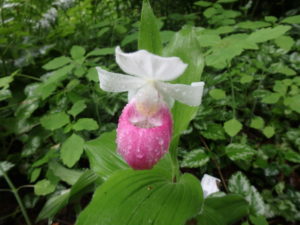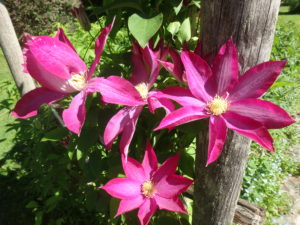Flowers in Bloom That Make Me Want to Swoon
My earliest memory of a flower dates back to spring, 1948, when I was just 2 years old and living in Hingham, Massachusetts (we moved away that fall, so I know the year). My mother, sister and I were walking through a pine woods when we encountered a cluster of pink ladyslipper orchids. I was enchanted. I wanted to pick it. My mom restrained me, saying it was a rare and special flower. I am still overwhelmed by their beauty, and feel lucky I can grow 2 kinds of ladyslippers.
There are 3 main types of ladyslippers that grow in the Northeast. A yellow ladyslipper (Cypripedium parviflorum), the pink one that I saw when young (Cypripedium acaule), and a bigger pink one called the showy ladyslipper (Cypripedium reginae). I grow the yellow and the showy.
The pink ladyslipper is tough to grow – it requires very acidic soil and is nearly impossible to transplant. In the wild I have only seen them in sandy soil under white pines.
The yellow and showy ladyslippers do fine in moist, rich soil and moderate shade. It is now possible to buy them at specialty nurseries. Some nurseries grow them and divide big clumps to sell individual plants. Starting any ladyslipper by seed is generally considered nearly impossible.
What other flowers now in bloom make my heart go Ka-Boom? My Japanese primroses, also called candelabra primroses (Primula japonica). I’ve grown these in the shade of some wild apple trees where the soil is rich, black and moist. Starting with just 7 plants, these have dropped seeds and self-planted so that I now have hundreds after 20 years. They are finishing up their bloom cycle now.
Candelabra primroses range in color from a deep magenta to medium pink to nearly white. They bloom up their stalks, presenting a ring of florets, then a second, third and sometimes even a fourth or fifth set of blossoms. Because they don’t all bloom at once, they flower for up to a month, depending on the heat.
Then there are the peonies. I have one, a division of my grandmother’s favorite, called ‘Festiva Maxima’. Grandmother died in 1953, and my mother dug it up and brought it to my childhood home. Then in the 1980’s I dug it up, divided it and brought some of it to New Hampshire. It is a double white with a speck of red in the middle. What makes it so special is the fragrance. It is enough to make the weak-hearted swoon.
If you don’t have a peony, or don’t have several, go buy one now when you can see the blossoms and judge the fragrance. Not all peonies have fragrance. Be sure not to plant it too deep. The ‘eyes’ or growing points need to be within an inch of the soil line. Otherwise they will grow and look healthy, but fail to bloom. Plant them with plenty of compost and some organic fertilizer added to a large planting hole.
I love roses. For ages roses bloomed mostly in June and suffered from black spot, Japanese beetles and other difficulties. No more. You can get roses that require no chemicals to stay healthy and bloom much of the summer. The only problem is that most of these modern hybrids have little or no scent.
Of the modern hybrids my favorite is the “Knockout” series. I have had singles and doubles, and find most are as hardy as a shovel (though much prettier). And I’ve had them bloom all summer and past Halloween.
But what I really love are the old fashioned roses. Many of them send up side shoots from the ground that can be dug and passed on. I have two of these, and I don’t know their varieties. I have a double white and a double pink, both with lovely scent. And despite the fact that I am an organic gardener who doesn’t spray them, they seem to stay free of pests and diseases.
I grow 5 kinds of clematis, and all are wonderful. Most clematis die back to the ground each winter, and start up in spring, though a few have hardy vines. Most grow 6 to 10 feet in length and need something tall to climb up. They have big, bodacious blossoms. Most are not particularly fragrant. They bloom in shades of pink and purple, along with white. The two I have in bloom right now have flat 6-petaled blossoms 4 to 5 inches in diameter. The most durable and vigorous is a purple one called Clematis jackmanii.
The trick to succeeding with clematis is to remember the old adage, they like “hot tops and cool bottoms.” The vines need to be in full sun, or full afternoon sun, and the roots need to be shaded. Plant something right in front of the clematis to help keep the roots cool.
June really is the best month for flowering plants. All those I mentioned above – and dozens of others – grace us with their presence. Go to a good family-run nursery where the staff really knows the habits of the plants and can tell you about each one. Most really enjoy educating you about the flowers, so ask questions. Of course, the best teacher is experience. So go get some new perennials and enjoy them.
Henry is a UNH Master Gardener, and the author of 4 gardening books. He lives in Cornish Flat, NH.





